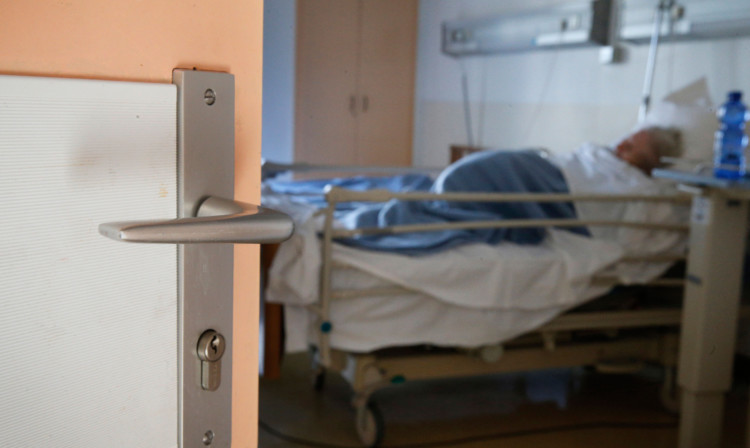
A&E wards blocked and overcrowded abandoned patients left on trolleys for hours
Left writhing in pain for six hours on a waiting room chair, this little boy marks a hospital bed shortage which has hit crisis point.
Today a damning Sunday Post expose uncovers the true extent of cuts to NHS hospital beds in England. We can reveal 23,000 overnight beds have disappeared from wards over the last four years alone.
The vanishing beds scandal has left seriously-ill patients like two-year-old Callum Giles, who was fighting a blood infection, abandoned in waiting rooms or left on trolleys in corridors. The cuts have followed a savage scaling back of services by cash-strapped NHS chiefs.
Medics argue the situation has been further compounded by cuts to social care budgets which means patients often the elderly and vulnerable cannot be discharged because care packages are not ready.
In recent months hospitals throughout the country have been rocked by a series of bed shortage scandals, including:
A grandad with heart problems forced to sit an entire night in a waiting room because there were no beds.
A 52-year-old woman suffering chest pains forced to wait 12 hours on a trolley.
Chronic delays in ambulances attending call-outs due to delays handing over patients at A&E.
Christina McAnea, head of health at Unison, said hospitals’ ability to cope had been heavily compromised by the lack of overnight beds. She claimed: “The Government’s lack of decent NHS funding is putting patients and staff under increasing pressure.”
She said bed shortages and high bed-occupancy rates were now the norm in hospitals, rather than the exception. She added already stretched emergency units were largely bearing the brunt.
Earlier this month it was revealed that, in the week ending June 15, 297,527 people attended major A&Es more than in any week since records began four years ago.
She added: “Staff in A&E often bear the brunt because they can’t find space on wards to take sick or injured patients. As a result, the department becomes blocked and overcrowded and ambulances end up queuing outside.”
She said the situation was compounded by a lack of local authority cash to provide care at home.
“Advances in medicine have led to shorter stays and most people do want to go home as soon as possible,” she added. “However, drastic cuts to social service budgets means many patients are discharged without having the help they need at home.”
The statistics, uncovered by Lord Kennedy of Southwark through a Parliamentary Question, have revealed during 2009/10 the NHS had 158,461 beds on wards which were open overnight equivalent to 3.04 per 1,000 people in England.
Four years later, in 2013/14, that number had plunged 14% to 135,964, which has left just 2.53 beds per 1,000 people. But over the same period beds on day wards increased slightly, from 0.21 per 1,000 people to 0.22 last year.
These fresh revelations follow a report, published by the Organisation for Economic Co-operation and Development (OECD) in April, which revealed the UK had fewer hospital beds per person than most of Europe. It found in 2011 England and Wales overall had 2.95 beds per 1,000 people, compared with Germany which had 8.3, Austria (7.7), Hungary (7.2), the Czech Republic (6.8) and Poland (6.6).
Jamie Reed, Labour’s shadow health minister who represents Copeland in Cumbria, accused PM David Cameron of setting the NHS “up to fail”.
He said: “With the NHS under severe pressure, fewer beds, more people trapped in hospital because councils no longer have the money to support them at home and longer waiting times mean more and more hospitals are becoming full to bursting.
“This comes at a high cost and it is patients paying the price.”
Last week the Health and Social Care Information Centre revealed half of all hospital beds were taken by over-65s and one in five people aged 85 or over had to use A&E last year.
It came as British Medical Association GP chief Dr Chaand Nagpaul warned two-week waits to see a GP are now the norm due to a “chronic” shortage of doctors.
Derek Barton, vice-chairman the North West Pensioners Association, warned elderly people are going to A&E in their droves because they have nowhere else to go. He said: “If you cannot see your GP you will go to where the lights are on, which is A&E, and then we got stuck there and called ‘bed-blockers’.”
Dr Mark Temple, who is the future hospitals officer at the Royal College of Physicians, said the reduction of beds was in line with the Government’s and NHS England’s aims of giving people more treatment in the community.
But he raised fears the policy was a “triumph of hope over reality”, claiming a lack of social care means patients ready to go home are blocking up beds.
“A lot of it is not from the front door, it is because patients are not able to move through hospital and be discharged in a timely manner.”
A Department of Health spokesperson said: “Bed numbers are not an accurate indicator of good quality care. The data reflects a long-term trend in a reduction of beds open overnight, as medical technology develops and more procedures are done as day cases.”

Enjoy the convenience of having The Sunday Post delivered as a digital ePaper straight to your smartphone, tablet or computer.
Subscribe for only £5.49 a month and enjoy all the benefits of the printed paper as a digital replica.
Subscribe